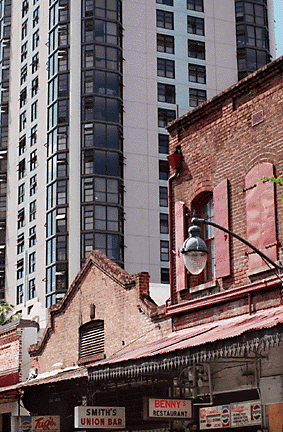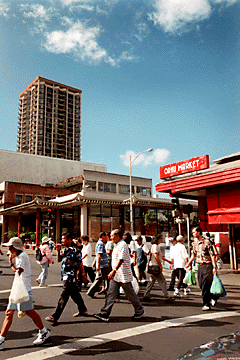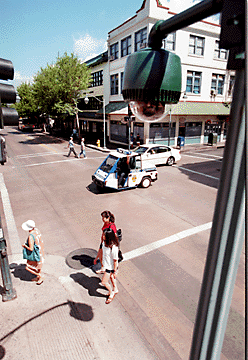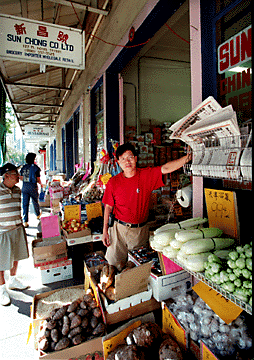


A city waiting to be reborn
See also: Future promise, past glory
By Peter Wagner
Star-BulletinIt's high noon and secretaries hustle up Hotel Street for the cheapest produce in town. Restaurants clatter. Noodle factories noodle. Customers step around a nonchalant cat.
Twenty years and $300 million after the city took in its troubled ward, Chinatown is back in business.
"It's like pulling something out of the ashes and dusting it off," said Roy Venters, who opened an art gallery on Nuuanu Avenue last year.
Crime is down. Businesses are venturing in. And the latest wave of immigrant shopkeepers - Chinese, Vietnamese, Cambodian, Laotian, Thai, Filipino, Korean - have brought vitality to the 150-
year-old neighborhood.
"It's come a million miles," said Mayor Jeremy Harris, who has made Chinatown a top priority. "It's an exciting place now."

The 15-block neighborhood has been through some major ups and downs in its colorful history. Once a hub of activity, Chinatown lit up the night in the late 1800s. Some 7,000 people and scores of shops and restaurants crammed the area, a rickety maze of wooden buildings and dirt streets bordered by what is now Nuuanu Avenue, Nimitz Highway, River and Beretania streets.Two fires, one purposely set in 1900, cleared Chinatown and its rats and the fear of bubonic plague. Streets were straightened, brick replaced wood, and the ornate Wo Fat Chop Sui building rose on the corner of Hotel and Nuuanu.
But Chinatown, hopping with G.I.s in the 1940s, hit the skids after World War II and slipped into porno and crime. The sleazy neighborhood and its problems were handed to the city in 1973 when the federal government declared Chinatown a historic area to be protected.
Harris and his predecessor, Frank Fasi, have since put more than $230 million into the area's "revitalization" - high-rise housing, underground parking, malls, street widening and lighting, surveillance cameras, parks and other projects.

Private developers, meanwhile, have invested at least $50 million in the old Hawaii Theater, Maunakea Marketplace, the newly opened Kekaulike Market and new businesses.All this has brought a population of about 3,000 residents to Chinatown, people who weren't there 20 years ago. But Honolulu's Chinatown has a way to go.
Crime, while fading, continues to scare customers away. The homeless sleep on sidewalks. And businesses, hit by Hawaii's economic slump, are off up to 50 percent.
One key hurdle, a city zoning ordinance that limited business lighting and signage in Chinatown, was removed last week when the City Council approved 18 square-foot neon signs and other lighting on buildings in the area.
The neighborhood's sober mood at night is in sharp contrast with Chinatowns across the country, where bright lights and business activity go hand in hand.
"Bright and colorful, that's what all Chinatowns are like," said developer Robert Gerell, a prime mover in the area's revitalization for the past 20 years. "Here, it's a dark, scary hole at night."
Keeping Chinatown open at night has long been a goal of the city administration, currently planning a $1.7 million project to upgrade street lighting in the area.
"We don't want Chinatown to be a nine-to-five place where you roll up the sidewalks at the end of the day and leave it to the drug dealers," Harris said.
Councilman Jon Yoshimura, who represents the neighborhood, said Chinatown presents a "chicken-or-egg" problem. New businesses won't bring light into the area without customers, and customers are afraid of the dark.
"One of the reasons it's so dark is there are no businesses open," Yoshimura said. "Where do you begin?"
Attracted by low rents, some businesses are taking the first step along Nuuanu Avenue - on the border between Chinatown and the downtown business district.
"People are still under the illusion that Chinatown is not a safe place to be," said Venters, whose The Studio of Roy Venters is just up the street from Havana Cabana, another newcomer. "They haven't been down here in a while. The area has really turned around."
Hank's Cafe Honolulu, which opened last month, is throwing its own light into the street next door to Smartitas Ink, and across from Punani's, another spot with night entertainment.

Juniroa Productions Inc., a video production company that specializes in Hawaiian documentaries, recently moved into the Hawaii Times Building on lower Nuuanu."It's an interesting part of town," said Esther Figueroa, a partner in Juniroa. "You're in a place that has some history and some character. There's a liveliness to it and a mix that you probably don't get anywhere else in town."
But few new businesses have ventured into Chinatown's dim interior. There, flitting along Smith, Pauahi and Hotel streets in the wee hours of the morning, are an assortment of drug dealers, prostitutes, and other troublemakers.
"Get up early and ride down Maunakea Street," said Harvey Amos, who starts work at Ono Bakery on Hotel Street before 5 a.m. "If you aren't propositioned 30 times within an hour I'll pay you $10."
Still, police say drug dealers and prostitutes are losing ground. Narcotics arrests this year are half the 1,000 cases in Chinatown last year, due in part to a tough federal crackdown dubbed "Weed & Seed" that keeps arrested suspects behind bars pending trial.
"It's making an impact," said Sgt. Lester Hite of the Honolulu Police Department, noting that Hawaii's drug laws allow suspects to post bail, putting them back on the street within hours of arrest.
Operating out of a small substation that opens onto the worst section of Hotel Street, the police have an energetic presence in Chinatown. Foot and bicycle patrol officers keep the misfits on their toes.
Surveillance cameras, to be operational in about two weeks, were recently installed on street corners.

And a new police station, twice the size of the current station, is to open on Hotel and Maunakea streets by the end of next year.Merchants in the area say crime is more a perceived problem that a real one in Chinatown. What concerns them more is parking.
While at least eight parking lots - most of them underground structures - are in and around Chinatown with more than 2,000 stalls, merchants complain their customers don't know where they are. Or they just don't like them.
"It's inconvenient," said Nhu Thao Duong, who operates Kim's Fashion on Maunakea Street.
Yoshimura notes that there is more parking in Chinatown now than ever before. But he agrees the new garages need a hard sell.
"Parking is not the problem people think it is," he said. "It's more a perceived problem than anything else. But our duty is to educate the public."
Yoshimura said signs should be improved to guide drivers to parking areas.
Not everyone in Chinatown is thrilled by the city's efforts to turn things around.
"Incredible idiocy!" said Joe Stacy, owner of Uncle Marv Pawn Shop near the end of Hotel Street. "Ten years ago there were 10 bars around here. The place was booming. Now there is nothing."

Too many bargains
Merchants compete for every dollar
By Peter Wagner
Star-BulletinThis used to be $7.95," said Kevin Lam, grabbing a bag of li hing mui from a shelf. The reddish mui was marked down to $4.25.
"I've cut my prices three times," said Lam, whose family runs Sun Chong Co. on Hotel St.
It's a great time for bargains in Chinatown.
But merchants aren't enjoying the free-for-all. For many of them, it's a matter of hanging on in a weak economy.
"A lot of people don't have jobs," said Lam. "If they have $10 to spend, they're very careful how they spend it."
Profits are down at least 15 percent this year at Sun Chong, and that hurts on this prime stretch of Hotel Street. Lam pays almost $4,000 a month for his 800-square-
foot store - about $5 a square foot. That's double the prevailing rates in Chinatown, which are currently at about $1.50 along Nuuanu Avenue.
At Ono Bake Shop nearby, business is off 80 percent in the past two years.
"We used to make $1,500 a day," said manager Harry Amos. "I'm lucky if I make $300 now."
Amos blames the economy, crime in the area, and newfangled parking structures that customers don't know how to use.
"There's a parking lot right across the street and nobody knows it," he said, gesturing out the door at the city's new Kekaulike Courtyards project.
Kim's Fashion, a small jewelry and gift shop on Maunakea Street, is struggling, too. Owner Duong Nhu Thao and his wife, Kim Phung Pham, haven't seen a profit in three years.
"I try to collect the rent only," said Duong, who opens early and closes late. "No profit."
Merchants say customers are shopping carefully.
"If our prices are even two or three cents higher, they walk away!" said Shirley Lam, who works seven days a week at Sun Chong Co. with other family members.
Parking was easier for her customers before the city built Marin Tower nearby and replaced a ground level parking lot with underground parking, she said.
"We're losing a lot of customers," she said. "They say there's nowhere to park."
Duong says heavy competition adds to the problem.
"So many stores follow me," said Duong, whose prices have fallen 30 percent in the past two years.
Mikee Sohriakoff, a former property manager who recently opened Mikee's Seafood at Kekaulike Market, says shopkeepers keep a close eye on each other.
"Chinatown is very competitive," he said. "People from other stores are out checking prices every day and adjusting accordingly."
